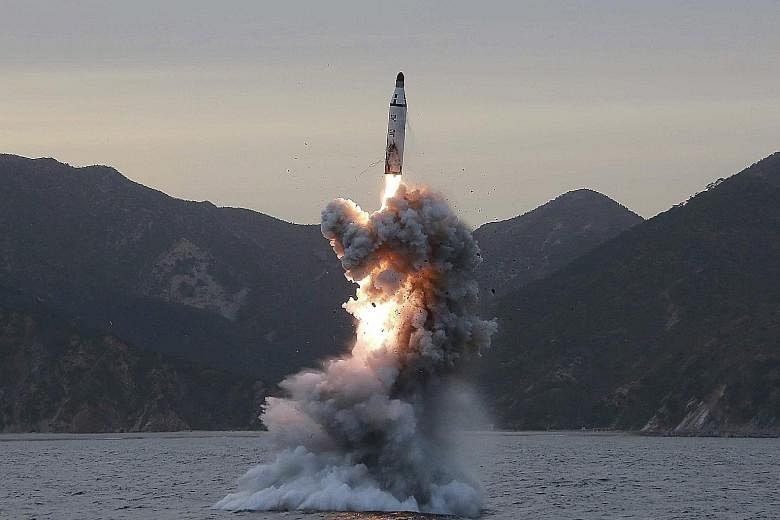SEOUL • Satellite images show that North Korea could be laying the groundwork for what could be its biggest nuclear test to date, according to a Washington-based research institute.
The isolated country is carrying out "substantial tunnel excavation" at its nuclear test site, which could support an explosion up to 14 times more powerful than its last test in September last year, said US scientists Frank Pabian and David Coblentz.
They wrote that the continued tunnelling under Mount Mantap at the Punggye-ri test site "has the potential for allowing North Korea to support additional underground nuclear tests of significantly higher explosive yields, perhaps up to 282 kilotonnes". Kilotonne is a unit of measuring the energy of explosion.
Their analysis, published on North Korea monitoring website 38 North, is based on commercial satellite imagery of the test site. The website is run by Johns Hopkins University's School of Advanced International Studies.
-
Sharp rise in Pyongyang's nuclear capabilities
-
The explosive force of North Korea's first nuclear device, tested in October 2006, was less than a kilotonne, which is 1,000 tonnes of TNT.
Its second test, in 2009, had more than double that force.
By January last year, the country claimed to have exploded a hydrogen bomb in a fourth test, but outside monitors expressed scepticism. Seismic readings suggested an explosive force of 4 to 6 kilotonnes.
Scientific analyses of North Korea's fifth test, in September last year, determined that the new bomb's explosive yield ranged between 15 and 20 kilotonnes.
North Korea monitoring website 38 North said satellite images of its Punggye-ri nuclear test site, where four of five nuclear tests were carried out, revealed substantial tunnelling works which could support an explosion as massive as 280 kilotonnes.
More ominously, North Korea in March last year displayed a new compact bomb, one that appeared small enough to fit inside the nose cone of one of its indigenously produced missiles.
Mr Robert Litwak, an expert on nuclear proliferation and director of international security studies at the Woodrow Wilson International Centre for Scholars, said Pyongyang's arsenal is believed to now contain as many as 20 nuclear bombs, along with enough plutonium and highly enriched uranium to make dozens more.
NYTIMES, WASHINGTON POST
North Korea conducted its fifth and most powerful nuclear test to date last September, with an estimated yield of 15 kilotonnes to 20 kilotonnes.
The report published by 38 North came a day after it warned last Thursday that North Korea could be preparing for another nuclear test.
Commercial satellite imagery taken last Tuesday of the North's Punggye-ri test site indicated movements and activities at the site's North Portal, the main administrative area and the command centre, said defence analyst Joseph Bermudez.
South Korea's Unification Ministry said North Korea is ready to conduct a nuclear test at any time.
"We are closely monitoring the situation while being fully alert against (North Korea's possible provocation)," ministry spokesman Jeong Joon Hee told a regular press briefing last week.
Tensions are high in the region after Pyongyang sent four ballistic missiles into the sea between the Korean peninsula and Japan on March 6.
North Korea's state agency KCNA said the missiles were aimed at United States bases in Japan. The launches coincided with largest joint US-South Korean military exercises, yearly drills which Pyongyang views as preparation for an invasion.
In response to North Korea's latest missile launches, the US accelerated the deployment of the first elements of its advanced anti-missile defence system in South Korea despite protests from China.
Today, South Korea and the US will kick off a computer-simulated command post exercise, codenamed Key Resolve, which is aimed at improving the combined forces' operation and combat capabilities to deter threats from the North. The war game is carried out in conjunction with Foal Eagle, a field training exercise that began on March 1.
The Nimitz-class USS Carl Vinson aircraft carrier is scheduled to arrive in Busan on Wednesday or thereabouts to participate in the ongoing drills, said Yonhap news agency.
US Secretary of State Rex Tillerson is travelling to the region this week on his first trip to Asia as America's top diplomat. He will travel to Japan, South Korea and China from Wednesday to Sunday.
Long-time observers say the risk of conflict is higher than it has been in years, and it is likely to rise further as North Korean leader Kim Jong Un seeks to fulfil his pledge to field long-range missiles capable of striking US cities.
"This is no longer about a lonely dictator crying for attention or demanding negotiations," said Dr Victor Cha, the Korea chair at the Washington-based Centre for Strategic and International Studies.
"This is now a military testing programme to acquire a proven capability," he told The Washington Post.

